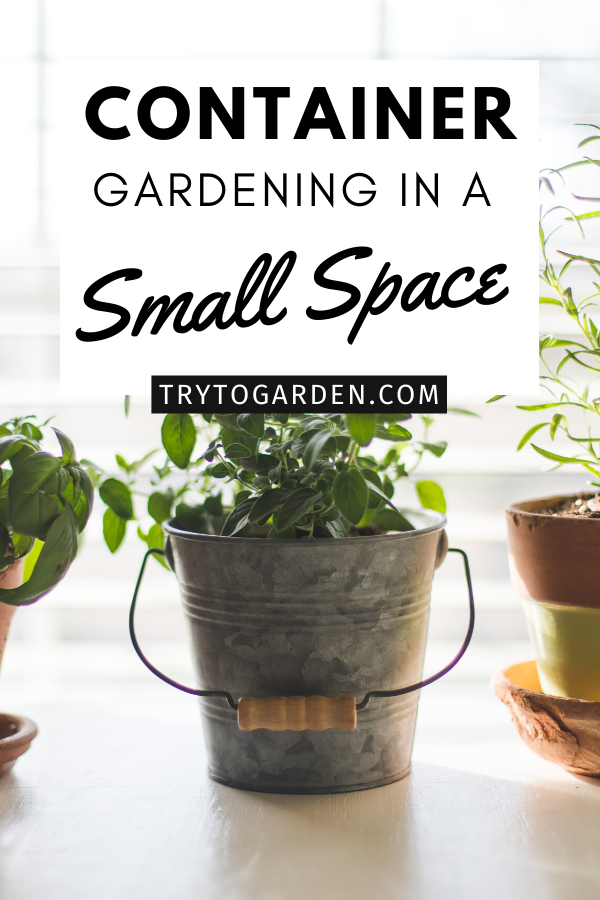This post contains affiliate links, which means I will make a commission at no extra cost to you should you click through and make a purchase. As an Amazon Associate I earn from qualifying purchases.
Let's talk about how to utilize small urban spaces, such as balconies, roofs, and patios, to grow vegetables for self-sufficiency. It is all about Container Gardening in a Small Space!

Many of us dream of a smallholding or homestead where we can live a self-sufficient life. But sadly, dreams and reality don't coincide. I am lucky, as I have a small allotment, but many people only have a small space, a yard, or a balcony. Can they achieve some degree of self-sufficiency? The answer is yes. They can grow vegetables in containers anywhere. Even a small balcony will let you produce something.
Container Gardening in a Small Space
Pick Your Pots
Let's look at how container gardening in small spaces works. If you have a yard or patio, then you can fill it with pots easily, but if you have a balcony or roof, you need to be careful not to overload it. However, there is a solution: use light-weight, improvised containers. For example, plastic rhino sacks. These light-weight sturdy sacks can be filled with compost and used as containers. You can use other plastic containers, but it is a good idea to wrap them in black material to prevent sunlight from decaying the plastic. It is essential to seek advice and permission from the owner of a building to ensure that you do not infringe on their legal rights. This is very important in terms of the balcony and roof gardens.
Easily grown vegetables
If you have a yard/patio, then any container of reasonable size will suffice. I use old tires. Getting them is easy. I beg them off the local garage owners, who are glad to see the back of them. I have grown potatoes, carrots, and peas in tire planters. It is often a good idea to plant one or more on top of the other to create a greater depth of soil. For carrots, which grow long if they have to send a root down for water, I insert a section of cut-down drainpipe and pour the water deep into the container soil, so the carrot roots plunge to drink and so lengthen. For potatoes, place a layer of manure at the bottom and cover it with soil. Don't fill the container at first, but earth it up steadily as the potatoes grow. Peas require some sticks to hold them up, and bamboo canes will be good enough. You can grow leeks in containers just as easily. Salad containers are handy. You can plant enough of a variety of salad plants for a week, using one container, and then use another one for the next week's salads and so on.
Anything can be used as a container, provided that it is large enough for the plant that you want to grow. Be advised that potatoes benefit from larger containers, as those produced in small ones can be on the small side. Refuse sacks or dustbins/trash cans work well.
But you must be careful to control moisture. I have known a container flood in heavy rain, which drowned the plant in it, so there must be drainage holes at the bottom. On the other hand, container soil often dries out, so you have to keep up the watering, especially in hot summers. Do not overwater so that the ground becomes soaked, as this will deprive the plant of the oxygen contained in the soil and kill it. A good idea is a moisture-retaining gel, available form various garden suppliers. This can be placed in the compost, where it will hold any extra moisture over and above what the plants need, then release it slowly as the compost dries.
Select Your Spot
You must place your container garden in a sunny area or choose shade-tolerant plants. Ideally, in the northern hemisphere, it should be south facing, but cabbages and other close relatives, like kale, can cope with shadier conditions than some other vegetables can. Grow lights can be used, but they take up much electricity, and the police might think you are growing cannabis, so you might be raided. You must also keep vegetables out of the wind. But do not let the plants sit in entirely still air, as it's the best way to get fungal diseases, such as mildew.
Many gardeners grow vertically as well as horizontally. The traditional garden grows flat across the ground, but you can use containers affixed to walls. Hanging baskets can be filled with strawberry plants, and bean or tomato vines can be trained to run up walls. All you need is some brackets and wire, and this takes the weight off a balcony. Tomatoes and peppers can grow indoors behind windows.
You can grow great vegetables in containers. While trying to grow giant pumpkins on a balcony or roof is not wise, most other vegetables will grow easily, given sunlight, water, compost, and tender loving care. You can turn an urban space into a small oasis of greenery that will help feed you and your family and provide you with something beautiful to look at. Container Gardening in a Small Space can really add a lot for your family!
Other posts you may find useful:
